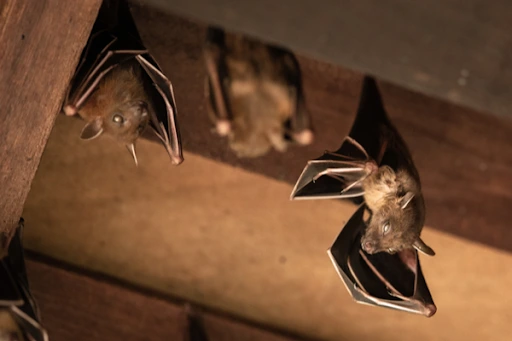A bat infestation can be surprisingly difficult to identify. Bats are skilled at hiding in secluded places, like attics, rafters, eaves, or soffits. However, there are telltale signs of bats that you can look for. If you notice any of the signs below, contact the professional bat removal experts at Varment Guard. A colony of bats can damage your home and become a serious health hazard, so don’t let your pest problem linger.
Signs of a Bat Infestation: How Do You Know if You Have Bats in Your House?
1. Droppings
Bat droppings are also known as “guano.” Bats eat insects and don’t generally need to drink very much, so their droppings are dry and flaky. They tend to look very similar to mouse droppings: small, black, cone-shaped, and solid.
To tell the difference between mouse poop vs bat poop, look for insect exoskeletons that sparkle when light is shined on it. Bat poop will also be larger than mouse poop. Be sure to always take precautions around bat droppings as they are toxic to humans.
Where To Look for Bat Guano
Guano tends to accumulate wherever bats roost, so it tends to pile up beneath places where they sleep. You may also find it near entry and exit points, such as window or door frames. During warm seasons, guano may accumulate around your porch, deck, or roof as bats fly in and out of their roosts to hunt. Bat droppings may be accompanied by urine.

Photo of Bat Droppings
2. Odors
Bats themselves don’t necessarily have a bad odor. They may have an earthy or woodsy musk. The foul odor you may smell is due to their waste.
What Does Bat Guano Smell Like?
Bat waste produces a strong ammonia smell, particularly when it begins to decompose. The accumulation of waste can also pose a serious health hazard. So if you notice this smell, call Varment Guard right away.
3. Urine Trails
Depending on the size of the infestation, you may be able to identify urine trails near roosting sites. Bats tend to urinate while roosting or in-flight, so their urine falls some distance and splatters. Likewise, bat droppings may break apart upon dropping or sitting for some time. Look for bat urine stains, splatters or dry, flaky dust-like remnants.
4. Black Stains Near Frames
Bats crawl into homes through small cracks and crevices around attics. They’ll find cracks near door and window frames or openings around siding or near utilities. Like rodents, bats can squeeze through remarkably small cracks to enter homes.
As bats squeeze through their openings, they leave behind a black, greasy stain from resin that accumulates on the bat’s skin. These stains may wear away at wood over time. Keep your eyes peeled for dark spots near places where bats might sneak into your home.

5. Scratches Along Walls
As bats struggle to squeeze through cracks and crevices, they’ll scratch nearby surfaces with their claws. Even after entering a home, bats will often scratch up rafters or walls while looking for places to roost. Bat claws are small, so look for a series of shallow, thin, and short cut marks.
These scratches will likely appear in the same places you’ll find the black stains. Bats also tend to carve up any surfaces they roost on, so you’ll find marks on rafters and pillars, too. They may also rip up insulation as they dig into your home, so look for insulation damage or stains.
6. Strange Noises at Night
Bats are famously nocturnal, which means they sleep during the day and wake up at night. Bats generally keep to this schedule relatively closely even after they’ve infiltrated your home. During the day, bats will hunker down in roosting hiding places and sleep. At night, however, bats will start to stir… and talk.
If you have bats living in your home, you might hear bats “squeaking” or “chirping” in your attic at night. Bats make high-pitched squeaking or “chattering” noises to communicate and find their way around.
Your Home is the Perfect Roosting Spot. Here’s Why.
Your home offers everything bats need to survive and raise their young. Here’s what makes it so appealing:
- It’s easy to get in. Bats only need a gap as small as ⅜ of an inch. Common entry points include roof vents, soffits and fascia gaps, chimney flashing, and loose siding.
- Plenty of roosting options. Popular bat spots include attics, rafters, and crawl spaces.
- Food. A home near water or woods has more insects to eat. Mosquitoes, moths, and beetles are all prime meals for bats.
- They were kicked out of a nearby spot. Bats excluded from nearby roosts may move to your home.
.png?r=uhAR2/+Zh2M=)
A Sign of the Season: Shifting Bat Behavior
As the seasons change, so does bat behavior around your home. In the spring, pregnant bats seek out warm, quiet attic spaces to give birth. By summer, these attics often turn into bustling nurseries where pups grow and learn to fly. Come fall, bats begin searching for stable sheltered areas to prepare for winter hibernation. During the colder months, particularly in older or drafty homes, some bats may hibernate inside attic spaces or even within walls.
This means that bats can be an issue for homeowners year-round. However, how a bat problem is dealt with is dependent on the season. For example, during the birthing season, bats cannot be excluded from a structure. Some states allow exclusion with a state-issued permit, but other states do not allow removal during the birthing season at all.
Varment Guard Can Help (Any Time of Year)
No matter the season, Varment Guard’s certified bat specialists are ready to help. In fall and winter, our team can inspect your home, identify how bats are getting in, and begin sealing up non-essential gaps—laying the groundwork for a full exclusion. Once all bats are safely out, typically using a one-way bat door left in place for 7–10 days, we complete the final seal-up. If it’s during the protected birthing season, we’ll adjust the timeline to avoid trapping flightless pups inside.
Ready to Solve Your Bat Problem?
Our team is prepared to humanely and effectively remove your bat problem and ensure your home is clean and healthy. Call Varment Guard right away








